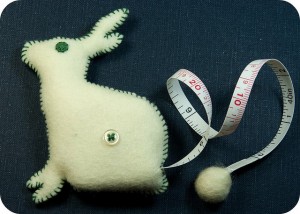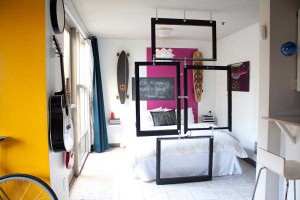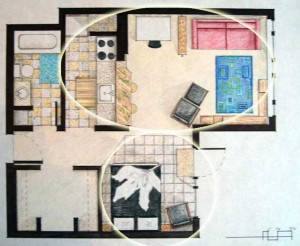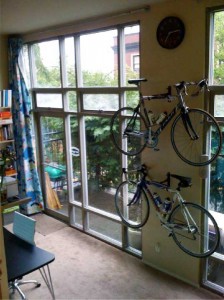How to Wear Designer-Goggles like a Champ
01 Sunday Apr 2012
Written by Amy
Every Room, Industrial Modern, Mid-Century Modern, Minimalist Modern, Organization, Painting, Planning
One of my favorite things about making a new friend is incredibly selfish. They haven’t seen my apartment yet, and when they do, they inevitably exclaim “I love your apartment!” So it got me thinking, if I get warm fuzzies from this, perhaps I am not the only one. But what about those of us in the world who didn’t shell out an arm and a leg to go to design school? Are they doomed to a life of beige walls, stock mini-blinds, and the oh-so-cold existence of one who has never received a compliment on their dwelling? Tis just too tragic a tale, so as a follow-up to my previous post about How to Shop for a Bad-Ass Tiny Apartment, this week I’m going to loan out my Designer-Goggles and tell you how to see the potential in your Bad-Ass Tiny Apartment.
Don’t See What’s There — Whilst apartment shopping, you probably realized that most rentals look like shit when they’re vacant. This is because the carpets are cheap, the walls are some version of white that is certainly not Benjamin Moore Super White, and they likely haven’t been subjected to the rigorous scouring and removal of previous tenant-ness. All that being said, you could still be looking at your dream apartment. So rule number one when attempting to don Designer-Goggles, is to look at the bones. Is the floor plan good? Are the windows nice and large? Do you like the vibe? If you answered yes, then ignore the superficial cover, because that is easily changed.
Don’t Fall Prey to the Empty Box — Even as an obsessive space planner, I still fall for the trap of the empty apartment. What does that mean? It means that it is hard to gauge scale when there is nothing in the apartment. Empty spaces play tricks on us, they can appear simultaneously larger and smaller than they really are. Don’t assume that your desk won’t fit in the living room, nor make the mistake of thinking that you can squeeze a sectional sofa into a studio apartment. To remedy this, make decisions based on cold hard numbers. For example, I know that my husband and I, and our three pups, can live comfortably in 500 square feet or more. Though I’ve seen smaller places that are fabulous, I know that we really do need all 500 square feet, and if the numbers are there, we can probably make it work, despite the layout.
Your Tape Measure is Your Best Friend - Another handy fact to keep in your tool belt is to always take your own square footage measurements. There are some crafty laws about square footage, and you don’t want to get burned by them. When I signed my first lease in Seattle, I didn’t have a tape on me and took the landlord’s square footage calculations at face value. After planning everything out and moving over, I discovered that I was missing 100 square feet. Where was said square footage? On the outdoor terrace. When you only have 600 square feet to begin with, 100 square feet can be an annoying thing to loose, so do yourself a favor and measure it out.
Play With It — As lousy as they may be at design, apartment developers likely had space for basic living functions in mind when drafting out the plan. Your first impression may be to put the dining room table here, and the sofa there, so this is where the Designer-Goggles really shine. There is more than one way to skin a cat (assuming you’re in to that kind of thing), and I certainly derive an obscene amount of pleasure in putting my sofa on the wrong side of the room and showing those developers that I, in fact, know best. The best apartments are unconventional and will scoff at the way the developers intended them to be used. So put on your thinking cap and step outside the box.
Paper Dolls — A good way to help kick start your creative juices, is to get a scale floor plan of the apartment. If one is not available, just take the most important measurements and put one together yourself. Then cut out scaled pieces of paper to represent each of your major furniture pieces. Grab a glass of wine and start moving them around. You might be surprised as to what fits where.
Slow Down Cowboy — Okay, so before you go too crazy with unconventionality, put down the glass of wine and pay attention. A good design takes public and private space into account. When you were playing with your paper dolls, you, no doubt, noticed that the bed will fit in the living room. That doesn’t mean you will be considered daring and designerly if you put it there. When challenging status quo, make sure that you have a clear delineation between what is considered public (kitchen, living room, dining room) and what is private (bedroom, bathroom, storage). These delineations do not need to be physical walls. In fact, I just designed a studio apartment that uses the Bomb-Proof Modular Shelving System as a very nice bedroom divider. There will likely be a whole other future post dedicated to ways of dividing space, so moving on…
What About the Bicycles? — When my husband and I shop for apartments, we have a long list of items that we need to think about. There are the normal things like where to put the furniture, and if we have room for our office that needs to be adjacent to the living area, but there are also the weird things. Where are we going to put four bicycles? Is there room for the guitars? Where will the long boards go? We have a lot of hobbies that the apartment developers probably did not plan for, so those are things that we consider right alongside whether or not there is room for the sofa. As a thoroughly interesting individual, I am sure you also have your own number of space-utilizing hobbies, so just watch out for them from the beginning.
Ask the Question — Before you sign a lease, talk to your landlord about what you can do to spruce the place up. You might be surprised. My landlord shocked me when she said we could paint, (and eventually even change the flooring). Even though the answer might be “no” you’ll never know until you ask. If it turns out that the rules are pretty strict, don’t despair, Apartment Therapy has a great article about how to make a rental look like you own it.
Moving On Up — For most people, moving means taking all of their stuff from one home, and putting it in another. For me, moving means taking all of my stuff from one home, and adapting it to fit in another. Most of my things are adaptable so that they always look like I designed them for the exact space they occupy. This can get a little spendy, but it really adds that extra something special. For example, I adapt my book shelving system to each apartment by either adjusting the height, mounting system, or configuration. My shelving system is one of the more attention-grabbing pieces that I have, and I’ll be damned if it doesn’t look awesome no matter where I happen to be living.
Thanks for reading. Please feel free to share, just please give me credit for my work when you do! Cheers till next time.







